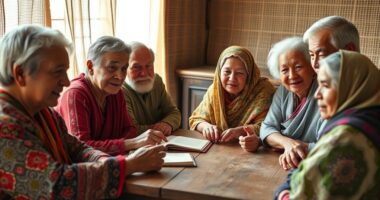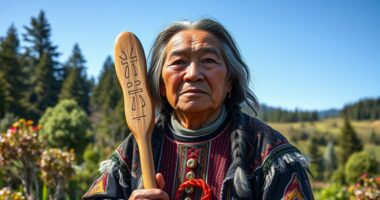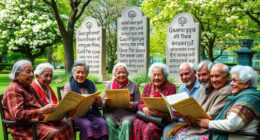In indigenous communities, multilingualism helps you preserve your cultural identity while managing several languages like local dialects, national tongues, and global languages. It enables you to communicate effectively within your community and beyond, opening doors to education and work opportunities. Balancing these languages shows resilience and adaptability. Your efforts to keep your languages alive reinforce your community’s rich traditions and resilience. To discover more about how these communities navigate their multiple tongues, keep exploring this essential topic.
Key Takeaways
- Indigenous communities often use multiple languages to communicate within their culture, with national and global languages for broader interaction.
- Multilingualism reinforces cultural resilience by allowing communities to maintain their native language while engaging internationally.
- Community-led initiatives, like storytelling and educational programs, support the preservation and transmission of indigenous languages.
- Navigating multiple tongues helps indigenous peoples adapt to changing environments and opportunities without losing cultural identity.
- Technology and cultural festivals enhance multilingual communication, strengthening cultural pride and ensuring language vitality.

Have you ever wondered how indigenous communities preserve their rich linguistic heritage amid global influences? It’s a delicate balancing act that involves more than just speaking a language; it’s about safeguarding cultural identity and ensuring that traditions, stories, and knowledge are passed down through generations. Language preservation becomes an essential tool in maintaining the community’s unique identity in a world that often pushes towards homogenization. When you’re immersed in such communities, you realize that speaking multiple languages isn’t just a practical skill—it’s a way of life that connects you to your ancestors and to the land. These languages carry stories, rituals, and histories that define who you are, making the effort to keep them alive a matter of cultural survival.
In these communities, multilingualism is both a necessity and a strength. Many indigenous people learn and speak more than one language because they navigate different worlds—local dialects, national languages, and global tongues like English or Spanish. This linguistic versatility allows you to communicate within your community and beyond, opening doors to education, employment, and international dialogue. Yet, despite these benefits, maintaining indigenous languages remains a challenge. The influence of dominant languages often threatens the vitality of local tongues, leading to language shift and, in some cases, language loss. That’s why community-led initiatives—like language classes, storytelling projects, and cultural festivals—are essential. They serve as active efforts to keep indigenous languages vibrant and relevant.
You can see that language preservation is directly tied to cultural identity. When you speak your native language, you’re not just communicating—you’re affirming your place in history and your community’s worldview. It’s about more than vocabulary; it’s about expressing values, beliefs, and ways of understanding the world. In multilingual settings, you often switch effortlessly between languages depending on context, which reflects a flexible and resilient cultural identity. This linguistic fluidity allows you to adapt and thrive amid changing circumstances while still honoring your roots. Moreover, the use of electric bikes and related technology highlights ongoing efforts to blend tradition with modern innovation, supporting sustainable development in indigenous communities. The effort to preserve indigenous languages amid the pressures of globalization demonstrates the importance of cultural resilience. It reminds you that language isn’t just a tool for communication but a vessel for your community’s history, identity, and future continuity.
Frequently Asked Questions
How Does Multilingualism Impact Indigenous Cultural Identity?
Multilingualism strengthens your indigenous cultural identity by fostering cultural preservation and promoting language resilience. When you embrace multiple languages, you connect deeply with your heritage, traditions, and history. This ongoing practice helps keep your cultural stories alive and resilient against outside influences. By steering through multiple tongues, you not only preserve your roots but also adapt and thrive within a changing world, ensuring your cultural identity remains vibrant and strong.
What Are the Common Challenges in Revitalizing Indigenous Languages?
Did you know that over 40% of indigenous languages are critically endangered? When revitalizing indigenous languages, you often face challenges like limited resources and gaps in language preservation. Community engagement becomes essential, as it encourages participation and intergenerational knowledge transfer. You need to foster local pride and support language learning initiatives, ensuring these languages thrive for future generations. Without active efforts, many indigenous languages risk permanent loss.
How Do Indigenous Communities Balance Traditional and Modern Language Use?
You balance traditional and modern language use by actively engaging in language preservation efforts while embracing cultural adaptation. You incorporate indigenous languages into daily life, education, and media, ensuring they stay relevant. Simultaneously, you adopt modern language tools and technology to reach younger generations. This approach helps maintain cultural identity, fosters pride, and keeps indigenous languages alive amidst changing societal contexts.
What Role Do Government Policies Play in Supporting Indigenous Multilingualism?
Imagine a garden where each language is a delicate bloom. Government policies act as nurturing rain, supporting indigenous multilingualism through policy support and language preservation efforts. They help safeguard these cultural flowers, ensuring they thrive amid modern challenges. By funding educational programs and recognizing native languages officially, policies empower communities to keep their linguistic heritage alive, creating a vibrant mosaic of voices that enriches our shared cultural landscape.
How Does Multilingualism Influence Intergenerational Communication in Indigenous Groups?
Multilingualism enhances intergenerational communication by allowing you to switch codes, making conversations more meaningful and culturally rich. You can preserve your language by passing it down through daily interactions, ensuring it remains vibrant across generations. Code switching helps bridge gaps between elders and youth, fostering understanding and respect. This dynamic keeps your indigenous language alive, strengthens community bonds, and promotes the ongoing transmission of cultural knowledge and traditions.
Conclusion
Embracing multilingualism in indigenous communities isn’t just about preserving languages; it’s about honoring resilience amid change. While these communities navigate modern pressures, their rich tapestry of tongues remains a proof to cultural endurance. You see, amidst the rapid flow of globalization, their ability to speak multiple languages highlights both vulnerability and strength. In holding onto their words, they forge a bridge between past and future, reminding us that language is both a heritage and a hope.
Mary is a passionate writer who brings creativity and a fresh perspective to our team. Her words have the power to captivate and inspire, making her an essential contributor to our content. Mary’s commitment to storytelling and dedication to promoting Indigenous culture ensures that her work touches the hearts of our readers. We’re fortunate to have her as part of our team.









